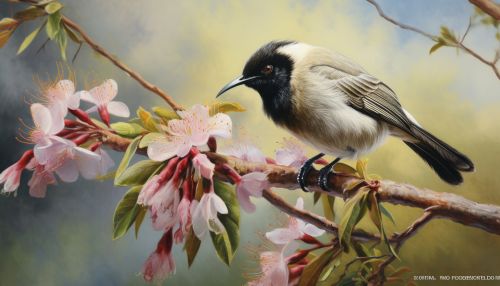Honeyeater
Overview
The Honeyeater is a diverse group of birds belonging to the family Meliphagidae, primarily found in Australia and New Guinea, but also in New Zealand, Hawaii, and the Pacific Islands. The family comprises over 180 species, which vary greatly in size, color, and behavior. Honeyeaters are known for their unique feeding habits, primarily consuming nectar from flowers, hence their name. However, their diet also includes insects, spiders, and sometimes fruits and seeds.


Taxonomy and Evolution
The family Meliphagidae was introduced by the English zoologist George Robert Gray in 1840. The name Meliphagidae is derived from the Greek words 'meli' meaning honey, and 'phagein' meaning to eat, reflecting the honeyeater's diet. The family is part of the larger superfamily Meliphagoidea, which also includes the pardalotes, Australasian warblers, and Australian chats.
The honeyeater family is an example of adaptive radiation, where a single ancestral species diversified into a variety of species to exploit different ecological niches. This is evident in the wide range of sizes, colors, and behaviors exhibited by honeyeater species.
Physical Characteristics
Honeyeaters range in size from the tiny 11 cm Scarlet Myzomela to the large 35 cm Yellow Wattlebird. The plumage varies greatly among species, from drab browns and greys to vibrant yellows, greens, and reds. Many species exhibit sexual dimorphism, where males and females have distinct appearances.
One of the defining features of honeyeaters is their long, curved bill, which is perfectly adapted for reaching deep into flowers to extract nectar. Many species also have a long, brush-tipped tongue, which they use to lap up nectar.
Behavior and Ecology
Honeyeaters are typically active and noisy birds. They are generally gregarious, often seen in large feeding flocks. However, some species are solitary and territorial. Their calls are varied, but many have a distinctive, melodious song.
Honeyeaters play a crucial role in their ecosystems as pollinators. As they move from flower to flower to feed on nectar, pollen sticks to their bills and feathers, which is then transferred to the next flower they visit, facilitating pollination.
Diet
While nectar is the primary food source for most honeyeater species, their diet is often supplemented with insects and spiders, particularly during the breeding season when the demand for protein is high. Some species also consume fruits and seeds.
Reproduction
Honeyeaters are generally monogamous, with pairs staying together for life. The female typically builds the nest, which is a small, cup-shaped structure made from twigs, grass, and spider webs. The female lays two to three eggs, which she incubates for about two weeks. Both parents feed the chicks, which fledge after two to three weeks.
Conservation
Many honeyeater species are common and widespread, but others are threatened or endangered due to habitat loss, introduced predators, and climate change. Conservation efforts are ongoing to protect these species and their habitats.
